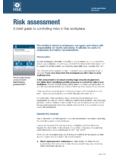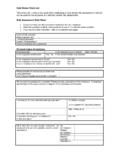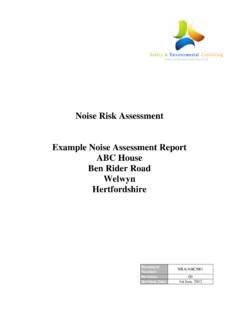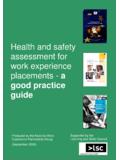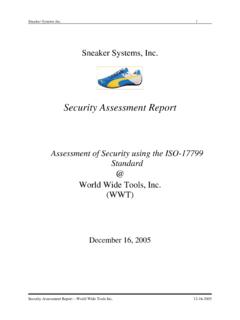Transcription of Risk Assessment & Method Statement One Stop …
1 Risk Assessment & Method Statement One Stop Asbestos Consultants & Services Ltd Risk Matrix Control Measures Instructions for Completion (Risk Assessment , Method Statement , Permit to work , Sequencing) 15-25: Very high risks with potential of serious consequences. Eliminate risk by review of options and change as a priority. 8-12: Reduce risks identified to as low as reasonably practicable by specific controls, planning and supervision. Provision of special Method statements and instruction of all parties involved. 3-6: Acceptable providing risks are managed and activities are carried out by competent personnel in accordance with safe working practices and statutory obligations. 1-2: No further consideration required. A risk is the likelihood of a substance, activity or process to cause harm. Risk is also linked to the severity of its consequences and can be reduced. L = Likelihood S = Severity RR = Risk Rating ( LxS) Remember to consider the effect of hazardous activities on other Works Packages and the Public Any site specific risk improvement requirements should be stated in the Existing Control Measures section in Italic print Ref No Method Statement Persons Affected Associated risks Risk Evaluation Required control measures and any site specific risk improvement requirements Residual Risk Responsibility for implementation Responsibility for monitoring L S RR L S RR 1 Arrival on site.
2 The analyst in charge will introduce himself to the resident and explain the proposed procedure to be carried out. After a quick tour of the premises he will brief other employees of any hazards specific to this property and the type of access equipment required for work at a height. During the survey residents will be asked to remain in a room with the door closed. Employees Residents None at this stage N/A Senior Analyst S Williams 2 Starting on the upper floor a management survey will be carried out in one room at a time. Access to roof void will be by ladder which extends at least into the void. Employees Fall of persons from a height Electrocution temporary lighting Trips and falls temporary lighting Insulation materials respiratory and skin irritation 3 3 3 3 5 5 4 3 15 15 12 9 Prior to use the ladder will be inspected for signs of damage. If damage is suspected the ladder must not be used, seek advice from S Williams.
3 The ladder should be footed or an anti-slip device in place at its base during use. Care must be taken once in the void, only stand on joists. All leads / lighting equipment used will be tested in accordance with the requirements of The Electricity at work Regulations 1989. Prior to use a visual inspection of the equipment will be carried out. Any damaged equipment must not be used. Leads / lighting equipment must be routed so as to minimise the likelihood of damage and tripping FFP3 respirator (or orinasal respirator with P3 filter) disposable coveralls and disposable surgical hand protection must be worn. 2 1 2 2 5 5 4 3 10 5 8 6 Senior Analyst S Williams Ref No Method Statement Persons Affected Associated risks Risk Evaluation Required control measures and any site specific risk improvement requirements Residual Risk Responsibility for implementation Responsibility for monitoring L S RR L S RR 3 Sampling techniques- As detailed in HSG 246.
4 Sampling locations to be thoroughly wetted prior to removal of the sample to reduce the risk of fibre release. Each sample is placed in a labelled sealed bag and placed in a second bag. Each sampling point will be sealed to prevent fibre release. If accidental fibre release occurs the area will be cleaned by H-type vacuum or by wet wiping. All sample points will be labelled. Employees Residents Exposure to asbestos containing materials 3 5 15 Only persons who have attended specific asbestos awareness / removal courses are permitted to carry out sampling work , as detailed in HSE publication L143. All persons involved in sampling work must wear FFP3 respirator (or orinasal respirator with P3 filter) disposable coveralls and disposable surgical hand protection. 1 5 5 Senior Analyst S Williams 4 Restrictions in sampling Where panels / ceiling tiles are asbestos containing these must not be removed to inspect any concealed void unless they can be easily removed without risk of breakage and then only to allow limited visual inspection.
5 Fitted carpets / floor coverings must not be lifted. Gas / electrical appliances must not be tampered with. Employees Residents N/A N/A Senior Analyst S Williams 5 On completion of work all samples will be placed in a sealed bag and removed from the premises. The equipment used will be removed from the premises and placed in the vehicle. Personal protective equipment will be removed when outside the premises and placed in a bag and sealed. The residents will be informed that work has been completed. Employees Residents N/A N/A Senior Analyst S Williams Ref No Method Statement Persons Affected Associated risks Risk Evaluation Required control measures and any site specific risk improvement requirements Residual Risk Responsibility for implementation Responsibility for monitoring L S RR L S RR 6 Other considerations It is reasonably foreseeable that during sampling work employees may come into contact with used syringes Employees Needle stick injury resulting in blood borne diseases, hepatitis, etc 3 4 12 Under no circumstances should employees touch a used syringe.
6 Contact S Williams immediately who should arrange to have the syringe removed from the sampling area 1 4 4 Senior Analyst S Williams 7a It may be necessary to work on the outside of premises to carry out sampling. Prior to any such work being carried out the work must be planned with careful consideration being given to the selection and use of access equipment. Mr S Williams is responsible for this undertaking and details entered by hand in section 8 below. Employees Residents Fall of objects from a height Fall or persons from a height 3 5 15 Ladders and step ladders Ladders should only be used for short term work , typically no more than 10 minutes at any one time or to gain access to a work area. Only Class 1 Industrial Heavy Duty ladders may be used. Any ladder or step ladder should be in good condition and inspected prior to use for signs of damage or defect. Damaged or defective ladders should not be used if the damage or defect could affect the stability of the ladder during use.
7 Tower scaffolds A tower scaffold must only be erected and dismantled by a competent person. The tower must be vertical and legs resting on firm, level ground. Wheels and outriggers must be locked. Employees and contractors must not climb up the outside of the tower, use an internal ladder to gain access to the work platform. Edge protection, guard rails (or other suitable barriers and toe boards) must be installed and kept in place around the work platform during use. Do not:- (a) use a ladder footed on a work platform or apply other horizontal loads which could tilt the tower, and (b) overload the tower. When moving a mobile tower:- (a) check that there are no power lines or overhead obstructions in the way, and (b) no person or materials remain on the work platform. 2 5 10 Senior Analyst S Williams Ref No Method Statement Persons Affected Associated risks Risk Evaluation Required control measures and any site specific risk improvement requirements Residual Risk Responsibility for implementation Responsibility for monitoring L S RR L S RR 7b As above Employees Residents Fall of objects from a height Fall of materials from a height Crushing injuries Electrocution Overturning of mobile elevating work platform 3 5 15 Mobile elevating work platforms (MEWP s) Only trained, competent and authorised persons are permitted to operate or work from a MEWP.
8 The safe working load of any MEWP must never be exceeded. Parts of the MEWP should not protrude into roadways or other traffic routes. Tyres must be properly inflated. A MEWP must not be operated close to overhead power lines, crushing or contact hazards. If working in or close to a traffic or pedestrian route warning notices and barriers should be erected. Tools and equipment placed on the MEWP must be positioned so as nothing is likely to fall to the ground when the platform is raised. A MEWP must not be moved in the raised position unless it is of a type designed to do so and this can be done safely. Persons working from the cage must not reach out excessively or stand on the cage handrails. Fall arrest protection In high risk situations persons using a MEWP , in particular cherry picker type access equipment will be required to wear fall arrest protection in the form of a full body safety harness attached by lanyard attached to a suitable anchorage point on the basket.
9 Situations which have been identified as high risk are where:- (1) There are protruding features which could catch or trap the basket; (2) Passing vehicles could possibly collide with, or make contact with the MEWP; (3) The nature of the work being done from the basket may mean operators are more likely to lean out. 2 5 10 Senior Analyst S Williams 8 Other considerations specific to an individual property

